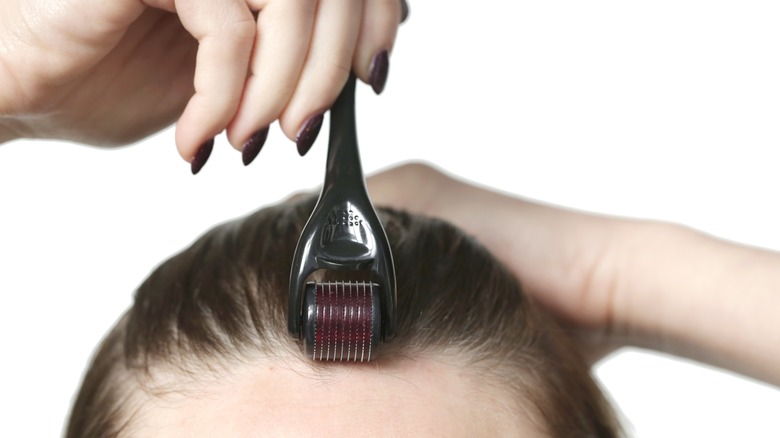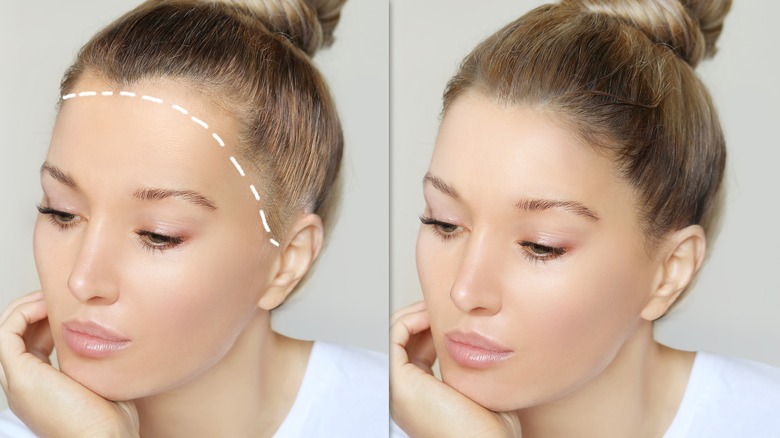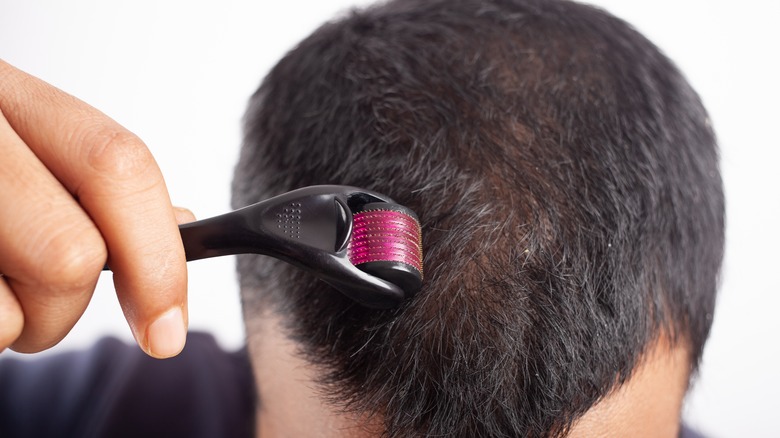Can You Treat Hair Loss By Derma Rolling? Here's What We Know
We may receive a commission on purchases made from links.
Amidst the many social media claims about derma rolling's potential to treat hair loss, it's essential to separate fact from fiction. Since derma rolling isn't as popular a subject when it comes to scientific studies — such as those to determine the best type of diet to promote hair growth — it's easy for misinformation to spread. To verify the facts, we examined three of the studies done so far that explored derma rolling's efficacy in treating hair loss.
However, before we proceed, it's important to establish what qualifies as "hair loss." The studies we reviewed specifically focused on androgenetic alopecia, which begins with a predictable pattern of hair thinning and subsequent loss. In men, this patterned hair loss begins with a receding hairline, while in women, it starts from the top of the scalp.
All three studies showed positive effects of derma rolling in assisting treatment for hair loss. However, it's worth noting that the results are more complex than they may initially appear. While each derma rolling study yielded positive outcomes, the research papers shed light on additional crucial information.
Derma rolling alone may not treat hair loss
None of the three studies done to examine hair loss utilized only derma rollers for treatment. In fact, there are no public studies on the efficacy of only derma rolling for hair growth. This is probably because derma rolling's major benefit for the scalp is aiding product absorption.
The first study, conducted in 2021 and published in the Tamil Nadu Dr. MGR Medical University online repository, combined derma rolling with platelet-rich plasma treatment. The second 2021 study, published in the Journal of Cosmetic Dermatology, incorporated a QR 678 hair growth serum, while the third study, published in 2016 in the Journal of the Egyptian Women's Dermatologic Society, used a platelet-rich plasma treatment and minoxidil mixture.
To achieve identical results to those observed in these studies, you'd need to combine derma rolling with a PRP or QR 678 hair treatment. Furthermore, it is important to note that these treatments were administered monthly, with most patients experiencing improvement in two to three months.
Now, the question is: Can you treat hair loss with derma rolling if a platelet-rich plasma or QR 678 hair treatment is not accessible? The answer is yes, but it's crucial to understand the limitations. Other alternatives, such as a hair growth serum or oil, may yield some but less significant results. We recommend using rosemary oil, one way to get longer and thicker hair, according to science.
How to use a derma roller to treat hair loss
To use a derma roller with your hair loss treatment, you should start with a clean scalp and gather the necessary tools: a hair growth serum or oil and a derma roller with a needle length ranging from 0.25 mm to 1.5 mm. If you don't have a derma roller, popular options include the Sdara Skincare Derma Roller or the Roselynboutique Derma Roller, equipped with 0.25 mm needles.
Roll the derma roller gently over your scalp for approximately two minutes. Ensure you cover all the affected areas while maintaining a steady and controlled motion. After derma rolling, massage your preferred hair growth serum or oil into your scalp. This will help deeply nourish and stimulate the hair follicles. Limit derma rolling to twice a week to avoid excessive stress on your scalp. Start with once-weekly treatments and gradually increase frequency as tolerated.
It's important to note that while derma rolling can be a helpful DIY option for hair loss treatment, the studies also revealed alternative methods with potentially better results. The 2021 Journal of Cosmetic Dermatology study found that intradermal injection therapy was more effective for hair growth than a derma roller. For more effective and quicker outcomes, consider consulting a trichologist or cosmetologist. These trained experts can access professional-grade hair products and techniques, such as intradermal injection therapy, which is a lot less painful than derma rolling.


